16.01.11 Jn. 19:19-22 (See also Mt. 27:37; Mk. 15:26; Lk. 23:38)
INSCRIPTION ON CROSS
19 Pilate also had a sign lettered and put on the cross. The inscription was:
JESUS THE NAZARENE
THE KING OF THE JEWS.
20 Many of the Jews read this sign, because the place where Jesus was crucified was near the city, and it was written in Hebrew, Latin, and Greek. 21 So the chief priests of the Jews said to Pilate, “Don’t write, ‘The King of the Jews,’ but that He said, ‘I am the King of the Jews.’”
22 Pilate replied, “What I have written, I have written.”
A sign, a/k/a titulus, was placed on the top of a cross of leading rebels or other significant persons.[1] It was seldom used otherwise. At the time the criminal was condemned, the titulus was carried by the leading soldier on a standard or was hung around the prisoner’s neck as he carried his crossbeam to the crucifixion site. After a prisoner was secured to the cross, the titulus was secured to the post over his head. Then all those who came by could read the prisoner’s name and the reason for his execution.
16.01.11.Q1 What were the words on the titulus?
There are five ancient documents that preserved the words on the titulus – the wooden sign that was placed on the cross above Jesus. Note carefully the literal translation of each:[2] While the wording differes slightly, all agree that Jesus claimed to be the king of the Jews. It also implied that He was a threat to Rome.
Mt. 27:37 “This is Jesus, the king of the Jews.”
Mk. 15:26 “The king of the Jews.”
Lk. 23:38 “The king of the Jews [is] this [man].”
Jn. 19:19 “Jesus of Nazareth, the king of the Jews”
Gospel of Peter 4:11 “This is the king of Israel.”
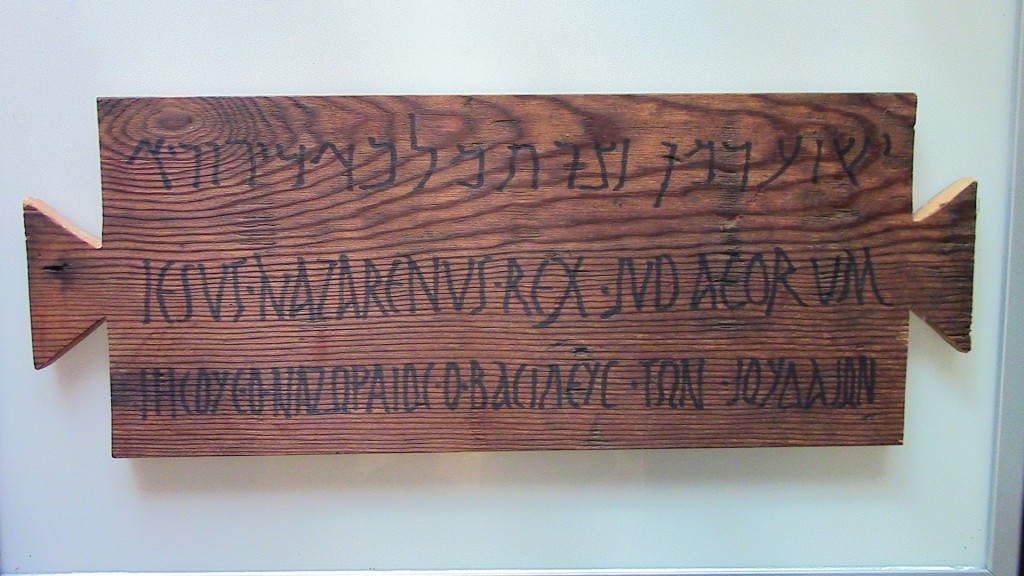 16.01.11.A. AN ILLUSTRATION AND REPRODUCTION OF A ROMAN TITULUS. An illustration (top) of a titulus with reproduction below. The titulus was a wooden placard carried by the condemned or by the lead soldier, on which was written the reason for his execution. Jesus most certainly carried a titulus with the phrase “Jesus, the Natzarene, the King of the Jews” written in three languages: Hebrew, Latin and Greek.[3] It implied that Jesus was a threat to Pax Romana.[4] Reproduction by Marlin King. Photograph by the author.
16.01.11.A. AN ILLUSTRATION AND REPRODUCTION OF A ROMAN TITULUS. An illustration (top) of a titulus with reproduction below. The titulus was a wooden placard carried by the condemned or by the lead soldier, on which was written the reason for his execution. Jesus most certainly carried a titulus with the phrase “Jesus, the Natzarene, the King of the Jews” written in three languages: Hebrew, Latin and Greek.[3] It implied that Jesus was a threat to Pax Romana.[4] Reproduction by Marlin King. Photograph by the author.
Again there is a question of what appears to be an apparent conflict.[5] Matthew, the former meticulous tax collector and bookkeeper, gave the most detailed account of the sign by recording the name of Jesus, while the other two synoptic writers simply presented the main idea of the sign, that this lifeless body was the “King of the Jews.” Since the people, by the demonstration of placing palm branches before Jesus at His triumphal entry, recognized Him as their king, His name became synonymous with “King of the Jews.”[6] Again, the three languages on the titulus simply reflect what each writer considered significant – but the theme remains the same throughout.
These variations of quotations are a classic example of ipsissima verba and ipsissima vox that was previously described (see 08.03.04.Q4). It is evident from ancient Greek writers that it was permissible to record the primary theme or exact voice (vox) faithfully, rather than obtain an exact quotation or exact words (verba).[7] Scholars agree that the accuracy of the gospel message does not demand verbal precision.[8] An example of Jewish writers conveying ideas without exact wording was discovered in a Dead Sea Scroll Fragment 4Q521, which is explained in this author’s commentary on Luke 7:18-23 (see 08.05.04).
It was the Roman practice to place a titulus over selected crucified criminals for the following three reasons:[9]
- The titulus announced the power and authority of the Roman Emperor to crush anyone who he thought might present a challenge. It was written in three languages: Hebrew (top row was the same as the Aramaic square script) Latin, and Greek, so that everyone passing by would know the reason for the execution.[10]
- To insult the Jewish leaders and the one whom they considered to be a false messiah.
- To humiliate the person being executed.
A legend that the titulus was taken to Rome where it is in a church on the grounds of the Sessorian Palace; a church known as the Santa Croce in Gerusalemme, or Santo Titolo in Gerusalemme.[11]
The brutality of a crucifixion was so severe that at times the prisoner was not recognizable, even to his family. Often the Romans prohibited the removal of the body and allowed it to decay and rot on the cross. Eventually dogs and wild animals would clean up the remains. However, the Jews were permitted to remove the body of a fellow Jew. The sign was to serve a function more than to identify the corpse. The cross was so cruel that the Romans abolished its use in A.D. 315. It symbolized a horrific death to the early church, but the meaning quickly changed to eternal life. For this reason, many early churches were built in the shape of a cross.
“The place where Jesus was crucified was near the city.” The Romans crucified Jesus according to Jewish custom – outside the city walls. Today, visitors are often told in error, that the Garden Tomb was the burial site of Jesus because it is outside of the Old City.[12] However, at the time of Jesus, Jerusalem had both the original city wall and a second wall that had been constructed by Herod the Great.[13] At that time, a number of people had their gardens north of the city outside the second wall. Gardens were not permitted within the Jerusalem city walls – the reason was that natural fertilizer (manure) made the city “impure.” [14] The exceptions were rose gardens with fruit trees. It was there that Joseph of Arimathea had his family garden and tomb.[15]
In the year A.D. 41, King Agrippa I ordered a third wall[16] to be built that enclosed the gardens, the Pool of Bethesda, as well as the crucifixion and burial sites of Jesus. Scholars believe that “third wall” was more for the protection of the food supply than for a defense of the city. When a gate was installed in the existing second wall, it was known as the Genath or Garden Gate.[17] That enclosed the area in which Jesus was crucified by the garden owned by Joseph of Arimathea. The city walls seen today, for the most part, were reconstructed on what was believed to be the existing foundations as determined by two 16th century architects employed by the Turkish Suleiman the Magnificent. Unfortunately, they were not very accurate in their assessment. Nonetheless, there is abundant archaeological and historical evidence to support the tradition that the Church of the Holy Sepulchre is both the crucifixion and burial sites, even though today it is located within the Old City walls.[18]
“What I have written, I have written.” Pilate again demonstrated how little he cared for the Jews. The Jews objected to the sign posted above Jesus, because it was a mockery to them. While Pilate could find no fault with Jesus, the Sadducees, elders, and scribes convinced him that Jesus was a messianic pretender with nationalistic aspirations. The Romans executed Jesus because,
- Pilate tried to appease the Jewish leadership.
- Officially Jesus was condemned for political reasons, although Roman observers never made a claim against Him during His life or ministry.
Jesus was not the only condemned person to have received a titulus. The church father and historian Eusebius, in his work on church history, wrote of an Attalus who was humiliated in an amphitheater, probably naked. In this case, the prisoner was not executed, but grossly humiliated which was a significant part of Roman punishment.[19]
He was led around the amphitheater and a placard (titulus) was carried before him on which was written in Latin, “This is Attalus, the Christian.”
Eusebius, Church History 5.1.44
Another case where the titulus was recorded is by the Roman historian Suetonius. He wrote of a slave owned by Emperor Caligula who was accused of stealing a strip of silver. The punishment was obviously rather severe.
At a public banquet in Rome he immediately handed over a slave to the executioners for stealing a strip of silver from the couches, with orders that his hands be cut off and hung around his neck upon his breast, and that he be led about among the guests, preceded by a placard (titulo) giving the reason for his punishment.
Suetonius, The Life of Caligula 32.2
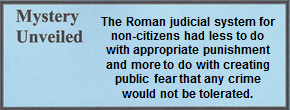
During the reign of Caesar Tiberius when Jesus was on trial, crimes deserving death were punished by a number of different methods. Those who were “well born” of aristocratic families and Roman citizens, were exiled to live out their last day. But for others, the end of life came much sooner. Note the following:[20]
-
- For some, it was decapitation by the sword. This would have been used on prisoners convicted of robbery or murder.
- For the “low born” there was the “ultimate penalty” or in Latin, summum supplicium,[21] which was death by extreme suffering if they committed any form of treason or revolt. This category of death penalties was not so much for just punishment as it was for instilling fear in anyone who would consider rebellion or treason.
- Being thrown to wild animals (bestiis dari) where prisoners were literally eaten alive by ravenous lions and tigers
- Being burned alive (vivus exuri or crematio)
- Crucifixion (crux). Within this form of execution, there were five methods used in Israel, as shown in the illustrations below. These methods were described, in part, by the Roman writer Seneca, and his words make modern readers shudder at the cruelty crucified men and women endured. It should be noted, however, that Seneca probably refered to crucifixions in Italy, as there is no record of any upside down crucifixions in Israel.
I see crosses, not indeed of a single kind, but differently contrived by different peoples; some hang their victims with the head toward the ground, some impale their private parts, others stretch out their arms on a fork-shaped gibbet.
Seneca, Dialogus and Letters 6.20.3
To insure that the maximum number of people would witness the execution, four Roman soldiers, two on either side of the prisoner, marched him through the busiest street of Jerusalem to the place of execution. The lead soldier generally carried the titulus or it was hung around the prisoner’s neck. There was hardly anyone in the Holy Land who had not seen a man get crucified. Furthermore, since extended families were large, there was hardly anyone who did not have a cousin, a distant cousin, or other relative get crucified.
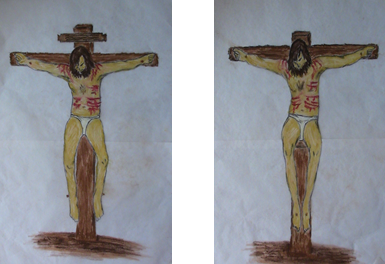
16.01.11.B. ILLUSTRATIONS 1 & 2 OF CRUCIFIXIONS. LEFT: The most likely way Jesus was crucified in order to meet all biblical requirements is shown in this illustration – not a bone was broken and probably no butt board to prolong His life. Over the head is a sign called a titulus. RIGHT: A prisoner is shown crucified with a nail through bones in each foot as he is resting on a butt-board that a small horizontal piece of wood called a sedulum. Illustrations by Diana Clegg.
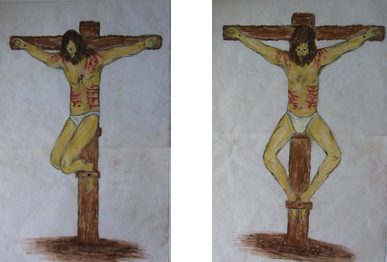
16.01.11.C. ILLUSTRATIONS 3 & 4 OF CRUCIFIXIONS. LEFT: A prisoner is crucified with legs to one side, resting on a butt-board with a board nailed to his feet. RIGHT: a modified crucifixion of Illustration 3 (Left). Illustrations by Diana Clegg.
The left image of 16.01.11.B is the only crucifixion method that meets all the requirements of the biblical crucifixion. It is well known that medieval artists depicted the feet of Jesus placed one over the other, pierced by a single nail.[22] That image is commonplace today although it is clearly misleading. All crosses had the posts secured in the rocky soil which stood as constant reminders to the local residents of pending death in the event there was a rebellion. There were essentially two kinds of crosses used in Israel.
- A high cross, known as a “high tau” cross because it was shaped like the capital Greek letter tau (T). Lifting a prisoner, after he was nailed to the crossbeam, to the top of the post was always a difficult endeavor.
- A low cross, known as a “low tau” cross, because it was shaped like a lower case tau (t). This was the most common type of cross. Jesus was probably tied to a low tau cross.
- In addition, when necessary, trees, whether dead or alive, were used when convicted prisoners outnumbered available crosses. The branches served as the crossbeam to which the prisoner was nailed, but usually tied with ropes.
Some scholars have suggested that the Romans may have used ropes instead of nails to occasionally crucify someone as was done with the Apostle Andrew.[23] That may have occurred if the supply of nails was exhausted, but generally, in the first century, criminals were nailed whenever possible.[24] Execution by crucifixion was not reserved only for men, as two ancient witnesses indicate.
- The Talmudic Tractate “Mourning” (Semahot) describes regulations pertaining to death, burial and mourning.[25] In section 2.11 the tractate refers to Jewish women crucified in Alexandria in the years A.D. 37-41. However, the event in Alexandria was in a different Roman jurisdiction, not in Israel.
- In Ashkelon, Jannaeus crucified eighty women whom he suspected of being witches, an account which was recorded in the Mishnah.[26] He stripped them naked and, for the sake of modesty, nailed them facing the cross where they died. The Essenes also wrote of this horrific event in their Dead Sea Scroll 4QpNah 1:6-8.[27] This was decades before the right of capital punishment was removed from the Jews.
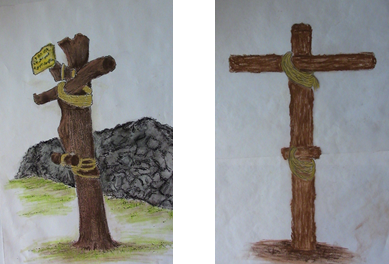
16.01.11.D. ILLUSTRATIONS 5 & 6 OF CRUCIFIXIONS. LEFT: A tree trunk by an stone wall (typical of olive tree orchards) ready for a crucifixion. RIGHT: Posts were secured in the stony ground and the cross-beam was attached with the prisoner nailed or tied with a rope to it.[28] Posts were constant reminders to the Jews not to revolt. When crosses or posts were in short supply, the condemned were crucified in live trees or two criminals to a cross. Illustrations by Diana Clegg.
According to one ancient writer, the Apostle Andrew was bound with ropes on a low cross, a/k/a “low tau” cross, so dogs and wild animals could eat his flesh as he was dying.[29] No capital punishment is pleasant, but some forms are worse than others. For the Jews according to the Oral Law, there were only four kinds of death penalties that could be ordered by the Jewish court:[30]
- Stoning
- Beheading
- Strangling
- Burning
Clearly, some of the Jewish rulers did not follow their own Oral Laws, as they used the crucifixion method that was not legal according to the Sanhedrin. The low tau cross was the most commonly used cross. At times a horizontal piece of wood was placed to support the buttocks to prolong the dying process. Both men and women were stripped completely naked when crucified to add immeasurable shame and humiliation to their punishment. Artists throughout history have shown Jesus on the cross as wearing a loincloth, but this is artistic license done to maintain His dignity and is not historically accurate.
It is difficult to comprehend the inhumanity of the Roman soldiers at time of war. When Jerusalem was under siege, Titus crucified all who attempted to escape, sometimes as many as 500 a day. The historian said that the soldiers crucified them in a number of different ways simply out of fun, and they even ran out of crosses.
So the soldiers, out of wrath and hatred they bore for the Jews, nailed those they caught, one after one way, and another after another, to the crosses, by way of jest; when their multitude was so great, that room was wanting for the crosses, and crosses wanting for the bodies.
Josephus, Wars 5.11.1 (451)
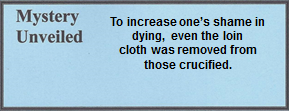
Roman citizens were exempted from crucifixion, yet the thought of it was so horrific that Cicero[31] said,
Let the very name of the cross be far away not only from the body of a Roman citizen, but even from his thoughts, his eyes, and his ears.
Cicero, Pro Rabirio 5
An Historical Summary of Crucifixion
The method of crucifixion has a long history, predating the Roman period. Scholars believe that crucifixion, in its earliest and crudest form, originated with the Assyrians.[32] During battles, they would place a pole in the ground and impale a captured soldier on the top of it, thus “hanging” him until he died an agonizing death. This had an incredibly demoralizing effect on the enemy.[33] Centuries earlier Joshua stated that the king of Ai (Jos. 8:23, 29) and the five kings of the Amorites were hung from trees (Jos. 10:5, 26-27). However, it appears that these were not live crucifixions, but the display of victory over the defeated and deceased kings.
It had long been used by the Persians and Carthaginians.[34] According to the first century Roman historian Curtius, Alexander the Great brought the practice into the Holy Land, but not until he first crucified two thousand citizens of Tyre who had surrendered.[35] Even the Jewish Sadducees, who were in power for most of the time after the Maccabean Revolt in the 160s B.C., practiced crucifixion. Between the years 90 and 88 B.C., they crucified an estimated eight hundred Pharisees (see 03.05.10). Obviously they had no second thoughts about killing Jesus because they had a well-established history of blood.
In the early first century B.C. era, Marcus Crassus was a Roman general and politician who helped transform the Roman Republic to an empire. He crushed the revolt at Spartacus and lined the road from Capua to Rome with crucified slaves who were captured.[36] Decades later, Caesar Augustus introduced its general use for anyone who revolted against Rome. There was absolutely no sense of compassion for those who rebelled against the empire, except an occasional centurion or a few local citizens.
Hanging on a cross often resulted in joints becoming disjointed. This must have occurred to Jesus as the Psalmist said,
I am poured out like water, and all my bones are disjointed;
my heart is like wax.
Psalm 22:14
To lessen the pain somewhat of this horrific experience, although it did prolong the dying experience, some prisoners were hung with a small horizontal piece of wood, called a sedulum, under the buttocks to relieve the pain of hanging. This was most likely not the case for Jesus.
[1]. Vincent, Word Studies in the New Testament. 2:283.
[2]. Literal translations and bracketed inserts by Robert Webb. See Webb, “The Roman Examination and Crucifixion of Jesus.” 747-49.
[3]. See 11.02.18.A, that also depicts a titulus on the Arch of Titus.
[4]. Mellowes and Cran, Producers. From Jesus to Christ: The First Christians. (DVD). Part 1; See “Pax Romana” in Appendix 26.
[5]. For further insight of the four variations of the gospel accounts, see 08.03.04.Q4 “What is the significance of verbal statements, “ipsissima verba” and “ipsissima vox?” Similar variations are found in 08.06.06.Q1 “Was the daughter of Jairus dead or asleep?”
[6]. Avi-Yonah and Kraeling, Our Living Bible. 295.
[7]. Wilkins, “Peter’s Declaration concerning Jesus’ Identity in Caesarea Philippi.” 345; Hagner, “Jesus and the Synoptic Sabbath Controversies.” 270; Hatch, The Influence of Greek Ideas and Usages. vii.
[8]. These scholars hold to the Reformed Doctrine of Biblical Inspiration on the concept of Ipsissima Vox: Stonehouse, Origins of the Synoptic Gospels. 109-10; Murray, Calvin on Scripture and Devine Sovereignty. 30; Hodge and Warfield, “Inspiration.” 238.
[9]. Stein, R., Jesus the Messiah. 247; See also Suetonius, Caligula 32.2 and Domitian 10:1; Dio Cassius, 54.3.7.
[10]. Harrison, A Short Life of Christ. 215.
[11]. Thiede and d’Ancona. The Quest for the True Cross. 66.
[12]. See Dr. Bryant Wood’s comments at 17.02.02.V1.
[13]. Price, The Stones Cry Out. 313.
[14]. Jeremias, Jerusalem in the Time of Jesus. 42.
[15]. Jeremias, Jerusalem in the Time of Jesus. 43.
[16]. In the 1960s a portion of the third wall was discovered by archaeologist Kathleen Kenyon, and in 1976, Magen Broshi discovered a portion of Herod’s city wall in the Sepulchre itself. See 17.02.02.Z, “Map of Jerusalem.” However, the exact locations of all the walls of the Old City, as it was in the first century, is a major problem for archaeologists and historians.
[17]. Jeremias, Jerusalem in the Time of Jesus. 43.
[18]. Bahat, “Does the Holy Sepulcher Church Mark the Burial of Jesus?” 26-40.
[19]. There appears to be no record of what happened to Attalus. When the local governor discovered he was a Roman citizen, Attalus was placed in prison and the governor inquired of the emperor of what to do with him.
[20]. Webb, “The Roman Examination and Crucifixion of Jesus.” 755..
[21]. Webb, “The Roman Examination and Crucifixion of Jesus.” 754-56.
[22]. Thiede and d’Ancona. The Quest for the True Cross. 66-67.
[23]. A brief description of the lives of the apostles in found in Appendix 27.
[24]. Robinson. “Crucifixion in the Roman World: The Use of Nails at the Time of Christ.” 42-48.
[25]. Robinson. “Crucifixion in the Roman World: The Use of Nails at the Time of Christ.” 33.
[26]. See 03.05.10. The Mishnah, Sanhedrin 6.4 states that it was Simeon ben Shetah who ordered the 80 women to be crucified.
[27]. Elgvin, “The Messiah.” 36. Young, “The Cross, Jesus and the Jewish People.” 27.
[28]. See the martyrdom of the Apostle Andrew in Appendix 27.
[29]. See The Acts of Andrew in Appendix 27, “The Faith of the Disciples and Gospel Writers.”
[30]. Mishnah, Sanhedrin 7.1.
[31]. Marcus Tullius Cicero (107-44 B.C.) was a Roman lawyer, politician and philosopher whose death came by an assassin.
[32]. Incidentally, Assyrian cruelty is why Jonah did not want to go to the Assyrian capital of Nineveh and preach repentance.
[33]. Tzaferis, “Crucifixion – The Archaeological Evidence.” 48.
[34]. Herodotus, Histories 3.128. Histories was written about 460 to 420 B.C; Polybius, The Histories 1.86. The Histories was written in the second century B.C..
[35]. Quintus Curtius Rufus, Historiae Alexandri Magni 8.
[36]. Gaius Plinius Secundus, also known as Pliny the Younger, Epistulae. 38 Cited by Geikie, The Life and Words of Christ. 2:557.